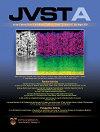三元 AlxGa1-xN m 平面本征表面态和费米级钉扎的成分依赖性
IF 2.1
3区 材料科学
Q3 MATERIALS SCIENCE, COATINGS & FILMS
引用次数: 0
摘要
有人认为,在非极性 III 族氮化物半导体表面生长是避免有害极化效应的一种补救方法。然而,由于非极性表面存在基带隙内的本征表面态,因此在生长过程中会出现费米级钉扎现象,从而影响掺杂剂和杂质的掺入。在器件结构中使用三元层(如 AlxGa1-xN 层)会使情况更加复杂。为了量化三元组 III 族氮化物非极性生长表面的费米级钉扎现象,利用横截面扫描隧道显微镜和光谱测定了非极性 AlxGa1-xN(101¯0)表面 III 族衍生空悬空键表面态的能量位置与铝浓度的函数关系。测量结果表明,随着铝浓度的增加,空悬空键态的最小能量线性地向中隙移动,斜率≈5 meV/%。这些实验结果得到了补充密度泛函理论计算的支持。本文章由计算机程序翻译,如有差异,请以英文原文为准。
Composition dependence of intrinsic surface states and Fermi-level pinning at ternary AlxGa1−xN m-plane surfaces
Growth on nonpolar group III-nitride semiconductor surfaces has been suggested to be a remedy for avoiding detrimental polarization effects. However, the presence of intrinsic surface states within the fundamental bandgap at nonpolar surfaces leads to a Fermi-level pinning during growth, affecting the incorporation of dopants and impurities. This is further complicated by the use of ternary, e.g., AlxGa1−xN layers in device structures. In order to quantify the Fermi-level pinning on ternary group III nitride nonpolar growth surface, the energy position of the group III-derived empty dangling bond surface state at nonpolar AlxGa1−xN(101¯0) surfaces is determined as a function of the Al concentration using cross-sectional scanning tunneling microscopy and spectroscopy. The measurements show that the minimum energy of the empty dangling bond state shifts linearly toward midgap for increasing Al concentration with a slope of ≈5 meV/%. These experimental findings are supported by complementary density functional theory calculations.
求助全文
通过发布文献求助,成功后即可免费获取论文全文。
去求助
来源期刊

Journal of Vacuum Science & Technology A
工程技术-材料科学:膜
CiteScore
5.10
自引率
10.30%
发文量
247
审稿时长
2.1 months
期刊介绍:
Journal of Vacuum Science & Technology A publishes reports of original research, letters, and review articles that focus on fundamental scientific understanding of interfaces, surfaces, plasmas and thin films and on using this understanding to advance the state-of-the-art in various technological applications.
 求助内容:
求助内容: 应助结果提醒方式:
应助结果提醒方式:


